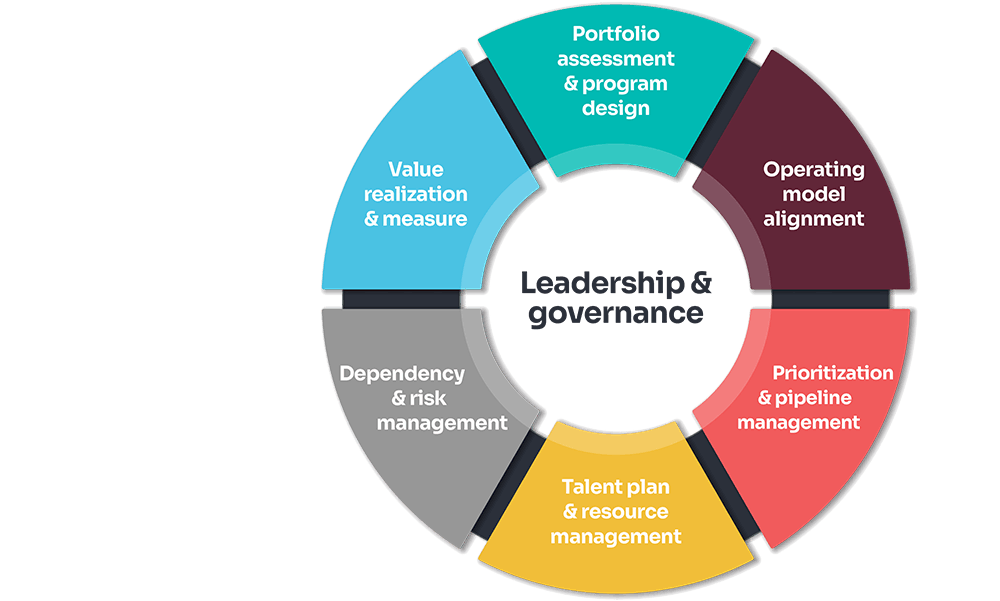
Article
The seven dimensions of successful program design and execution
Every business thinks that their situation is unique – and they’re right. Each business finds itself in a different place with specialized goals and challenges that they need to address. With each challenge often requiring multiple related initiatives. For this customized approach, there are few built-in answers and automatic solutions.
While building a custom designed program is essential for each business, there are seven key foundational dimensions that can lead to a successful program transformation that is both unique to your needs and responsive to your objectives.

Leadership and governance
True transformations do not happen without the aligned support and guidance of senior leadership, from the executive suite to key operations leaders across the impacted functions of the organization.
This dimension focuses on alignment of program strategic objectives/outcomes across the company’s group of knowledgeable, vested and empowered leaders. A well-designed program will encompass the support, guidance and collaboration processes for review/management by this set of leaders.
Portfolio assessment and program design
Good program design is focused on clear understanding of the strategic goals and objectives for the business and the vision for what investment/work is necessary to achieve those goals and objectives. This is typically embodied in a strategic road map, with an associated business case. The goal of a strategic road map is not to represent the specific delivery plan for the work, but rather the nature of the work, what/who it impacts, the high-level scope and the relative priority/order of work.
This dimension of our framework focuses on the confirmation of existing strategic planning/road map work, before translating that valuable work into an actionable plan for delivery that recognizes the appropriate delivery methods (agile, product owner, etc.) for each work component (or groups thereof according to shared scope).
Operating model alignment
Programs that do not integrate an understanding of the current and future operating models of functions that are a part of the transformation fail as a result of poor alignment.
This dimension ensures that the program is always aligned with organizational strategies and is agile enough to cope with unexpected changes, taking necessary actions to deliver anticipated business value.
Prioritization and pipeline management
Transformative programs require a significant investment, whether that be in time, talent or money. Successful programs understand the interrelated dependencies of the planned components as well as the interlocking benefits generated from each successful completion.
This dimension focuses on the initial prioritization of the required, planned components and the ongoing process of initiating, launching and monitoring component projects, including new candidate work.
Talent plan and resource management
A commitment to personnel and resources is necessary for a program design to succeed, from technology teams tasked with implementing new solutions to key business subject matter resources. Additionally, the future state goals of the transformation often require those same individuals and many others in the organization to develop and acquire new skills to operate effectively, sustaining the realization of value.
This dimension focuses on estimating, planning, evaluating and allocating cross-project resources to optimize utilization and productivity while also supporting the developmental needs of the transformation.
Dependency and risk management
Understanding and managing the potential risks for each work component of the transformation program, the immediate impact of realized risk to that work and the cascading risk to other work components, is necessary to proactively control and mitigate risk effectively.
This dimension focuses on identifying/managing all critical interdependencies within the program work components and integrating that understanding in a structured risk management plan.
Value realization and measure
Prediction and scheduling of value attainment in transformational programs is sometimes difficult due to the nature of work that requires analysis to describe the future state and ongoing innovation to fully understand the ultimate capabilities necessary to achieve that future state.
This dimension focuses on the planning, forecasting and measurement of value in complex transformation scenarios, such as the operating metrics and value assertions that are important performance indicators. This dimension also focuses on the effective transfer of capabilities from the program to day-to-day operations management of the organization, continuously measuring the actual value achieved against the business case and providing actions and recommendations to maximize it.
Bringing the seven dimensions together
We focus on these seven dimensions to make digital program design and execution successful, but not all seven categories require the same level of focus and attention. Sometimes a transformation requires us to focus more attention on one or two areas, particularly if we discover an issue, or an area of vast potential that requires us to explore in greater detail.. We consider all seven dimensions and ask, for each one, whether the people, policies and tools are in place to help the business be successful in its unique transformational journey.
For more information about Baker Tilly’s program design and execution services, or to discuss how we may be able to assist your organization, contact us.
